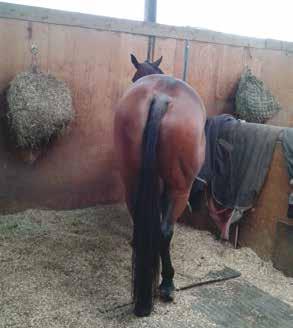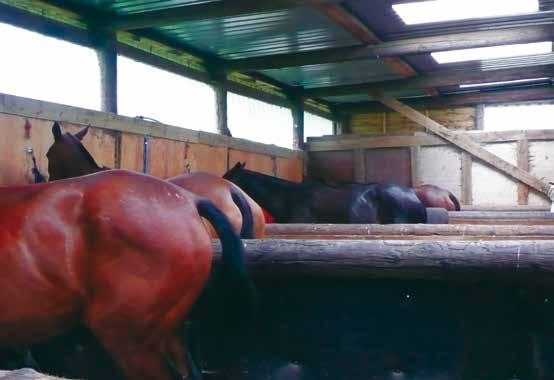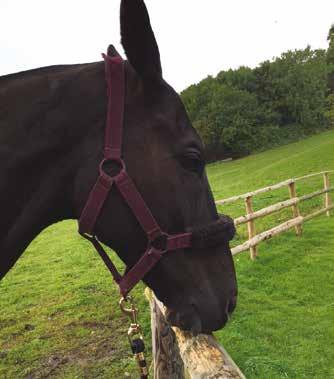
8 minute read
Nutrition Focus: Crib Biting
by Edit
Lorna Edgar – specialist equine nutritionist
Crib Biting & Windsucking
Advertisement
Why do they do it & how can we help?
Adam’s passion for this topic has found him adapting management changes to his own horses from research he has read. He feels further research and studies should be encouraged in this area of behaviour.
Case Study
Raven (two-year-old gelding) arrived at Adam’s property from a commercial racing yard as a chronic cribber and windsucker. The introduction of ad lib hay, 24/7 turnout and a friend of his own age and sex reduced these stereotypies by over 90 percent. He has now not been seen to display these behaviours in over three months despite returning to a stabled regime. Age is a factor in the success rate of reversing stereotypies.
This nice open barn allows social interaction between the horses
Photograph courtesy of Oli Hipwood
After researching and reading some Instagram posts by Adam Buchanan @pairbonding, I felt a combined article on behaviour and nutrition might be an interesting topic to explore and how, or if, we can help reduce stereotypical behaviours that affect many polo yards.
We all know that noise, as they gulp in air and make the grunt louder than Maria Sharapova! More often than not, we invest in a collar to stop them from doing it. But is this the best thing to do? Are there reasons as to why horses do this, and what are the ideas and suggestions as to how we could reduce these behaviours without using collars?
Why Do They Do It?
It has been suggested that oral stereotypies may be due either to an attempt to buffer acid in the stomach by increasing the production of saliva1 or due to gastric ulceration related to stomach acidity2. Nicol et al (2001) and Mills and Macleod (2002) reduced cribbing behaviour in young and adult horses, respectively, by feeding an antacid diet, suggesting that gastric acidity may play a significant role in oral stereotypy. The reduction was particularly evident in the period after feeding3, a period that has been particularly associated with intense stereotypic behaviour by cribbers.4
Oral stereotypic behaviour is not caused directly by diet quality or minimal foraging that it requires, but instead by its consequences for gut function. Lowfibre, high starch diets are known to cause gastrointestinal dysfunction, including gastric ulcers. Gastrointestinal acidity leads to suggestions that cribbing behaviours are responsible for gut health and perhaps even have some beneficial effects, for instance generating saliva that, if swallowed, helps to rectify gastrointestinal pH.
The brain chemistry and physiology of cribbing horses is that when they are fed, it tends to stimulate pleasure receptors in the brain as the endorphin release from their feed influences the behaviour or reinforces it.
Some may believe, once a cribber always a cribber, but some behaviourists believe cribbing is not a vice, but a response to adapting to situations that are not so natural or are stressful to them. There are some suggestions that it maybe a genetic trait, and there are suggestions that the behaviour is not copied by its ‘neighbour’.
Researchers still are not sure why some horses crib while others managed the same way do not. But most agree that it is not “contagious”— horses do not adopt this behaviour by mimicking others. “There are many non-cribbing horses kept in stalls next to cribbing horses who don’t learn this behaviour,” says Amelia S. Munsterman, DVM, PhD, DACVS, DACVECC, of the University of Wisconsin–Madison.
Studies have shown a close association to feeding time and the amount of crib biting increasing, peaking before and after feed. Some horses can spend up to eight hours cribbing each day, performing thousands of


Photograph by Polo Times Crib biting can be caused by a variety of causes such as stress or poor nutrition bites. Having forage present during this time can often reduce the prevalence of cribbing and wood chewing.
Behaviours that exhibit those natural foraging attempts can be driven by dietary deficiency of key nutrients and insufficient gut fill. Wood chewing may be a response to a lack of dietary fibre, but still allows them to chew and gain some gut fill.
Horses that carry out this stereotypical behaviour have shown a reduction in the stress hormone, cortisol, and in their heart rate, which is therefore suggesting that horses allowed to crib are less stressed. The brain chemistry and physiology of cribbing horses has shown that when they are fed, their pleasure receptors are stimulated in the brain as endorphins (the feel-good hormone) are released. It is well understood and acknowledged that equines crib not so much to get the high; they are getting the endorphin release from something else that’s occurring, like their feed, and then that influences the behaviour or reinforces it.5
Cribbing has been linked to endorphins and opioid stimulation, but it may be the receptors in their brain eliciting that pleasure response which reinforces the cribbing. It has been suggested that horses that are known to crib often have underlying digestive system dysfunction and are prone to colic.
Horses that crib have shown to have… · Significantly more inflamed, dry and ulcerated stomachs · Lower faecal pH · Longer gut transit times · Reduced hindgut motility · Imbalance in hindgut flora (acidosis)
Interestingly, research has shown that there may be a link between foals receiving a high starch diet at weaning and incidence of cribbing starting. There may also be a link to feeding a haylage that is wet (low dry matter) to the onset of cribbing and wood chewing in foals, where a soft digestible hay with a high dry matter, was preferable. These behaviours emerge soon after weaning, a process typically involving a switch to a high starch diet during a stressful time.6
What Are the Possible Causes?
· Lack of chewing time – a lack of saliva produced to help buffer stomach acid · Lack of chewing also effects their psychological need to chew · Not maintaining normal gut function – primarily where trickle feeding is not emulated and consequently the 10-12 litres of water that would be produced in this time is not. · Low-fibre and high starch diets increase the risk of gastric ulcers · Increased acidity of the digestive tract possibly leads to the incidence of cribbing to help relieve acidity, particularly by increasing saliva production to help increase the gut pH · Lack of turnout · Social isolation
How Can We Help to Prevent Cribbing?
Traditionally, collars are used to prevent cribbing. However, preventing a horse from cribbing has stress related physiological effects. When the collar is removed the horse will want to crib rapidly to make up for the time it had the collar on. Often horses that have a collar on or are deprived of cribbing will want to eat more – if they do not have enough forage and they’re prevented from cribbing, their slow gut transit is exacerbated. · Stables & Bedding – The size of the stable is not thought to have an effect on the cribbing horse and oral behaviour but trying to promote visual contact between horses can help to reduce behaviour.
Using loose straw bedding can reduce the incidence of oral stereotypical behaviour, such as cribbing. · Toys – Provide toys for oral stimulation.
Toys may help keep a horse’s mouth busy and distract him from cribbing.
Those that encourage oral activity, such as licking or chewing, may be especially helpful. · Mirrors (the Reversal Effect) – The mirror may mimic visual contact with conspecifics (minimising the social isolation of the stable) and /or provide environmental distraction or additional visual stimuli, altering the horse’s perception of the environment and their resultant responses to it.7
Dietary Changes
Generally, I would encourage the management of a horse that cribs to be similar to that of a horse with gastric ulcers… · Use a LOW STARCH concentrate feed o GOOD DOER – offer a balancer with an alfalfa chaff or beet pulp o POOR DOER – opt for a low starch cube or mix such as Baileys Ease & Excel Cubes or Mix o Focus on digestible fibres and oils as energy and calorie sources rather than oats, for example · Make sure you offer a HIGH FIBRE diet, allowing ad lib forage o If possible use hay rather than haylage · Offer small, regular meals rather than two large meals · Provide a pre/probiotic – especially if the droppings are smelly, suggesting acidosis in the hind gut · Use an antacid based supplement (Protexin Acid Ease, NAF GastriVet) to help neutralise excess acid in the stomach · Make changes to the diet gradual over 10-14 days to reduce the increased stress on the digestive tract · Offer small meals of alfalfa chaff during the day – ESPECIALLY 20 to 30 minutes prior to exercise · Consult a nutritionist or feed company help line for guidance · Treatment of cribbing foals with antacid may be advantageous8. These strategies, as well as using a low starch, high fibre, high oil ration, also might work to reduce cribbing frequency in adult horses
Summary
· Don’t try to stop them! (when horses are allowed to crib, they are less stressed!) · Evaluate their diet as above · Ad lib hay · Feed the stereotypic horse at different times, so there is no peak time · Maximise turnout space and time · Five to 20 minutes grazing daily · Promote psychological wellbeing with a companion for social interaction · Toys that promote licking, chewing or oral behaviour – Equiball, treat balls, salt licks · Opt for straw bedding
I would like to thank Adam for helping me to put this article together. We can never underestimate how we, as humans, affect the behaviour of horses, and especially performance horses. The more we can work with them and reason their behaviour and adapt our management, the more we can help to enhance their performance.
Contact Lorna Edgar of Baileys Horse Feeds on lorna@baileyshorsefeeds.co.uk
References
1Nicol 1999 2Nadeau and others 2000 3Mills and Macleod 2002 4Kennedy et al 1993, Gillham et al 1994, McGreevy et al 1995 5Heather Smith Thomas, 2020 6Christa Lesté-Lasserre, 2013 7Lynn MMcAfeeDaniel SMillsJonathan JCooper 19 July 2002 8Nicol et al, 2002










